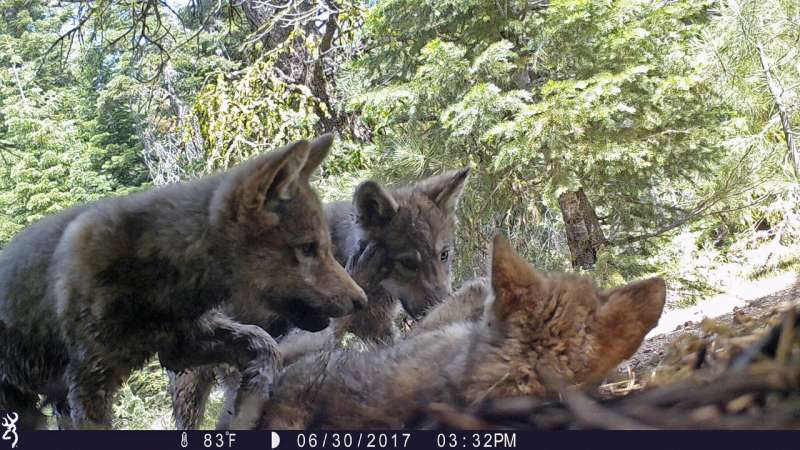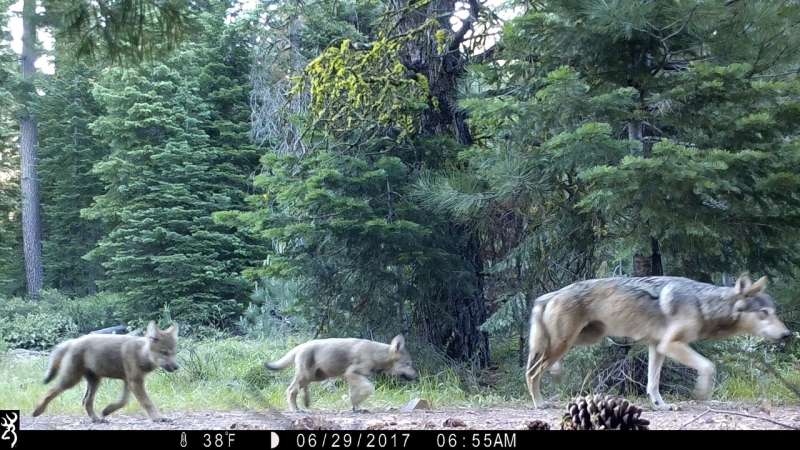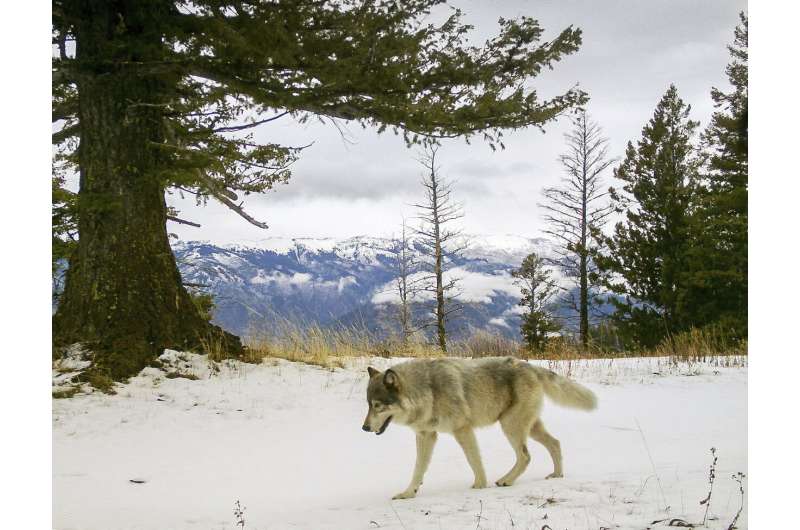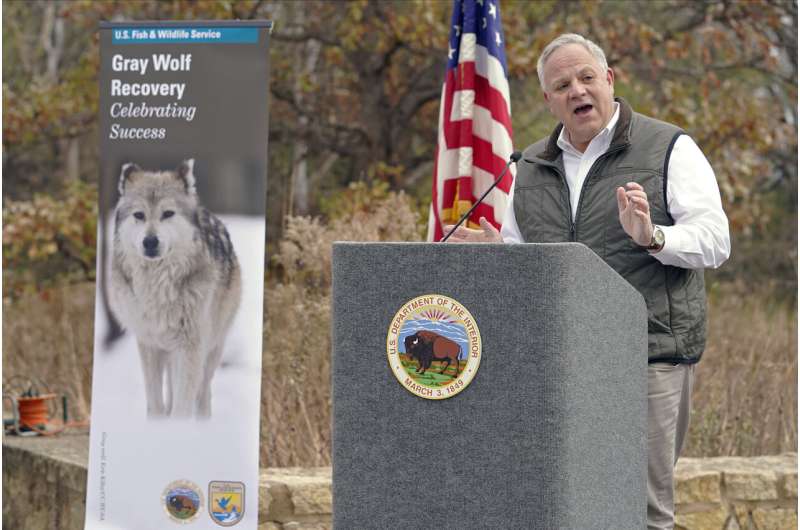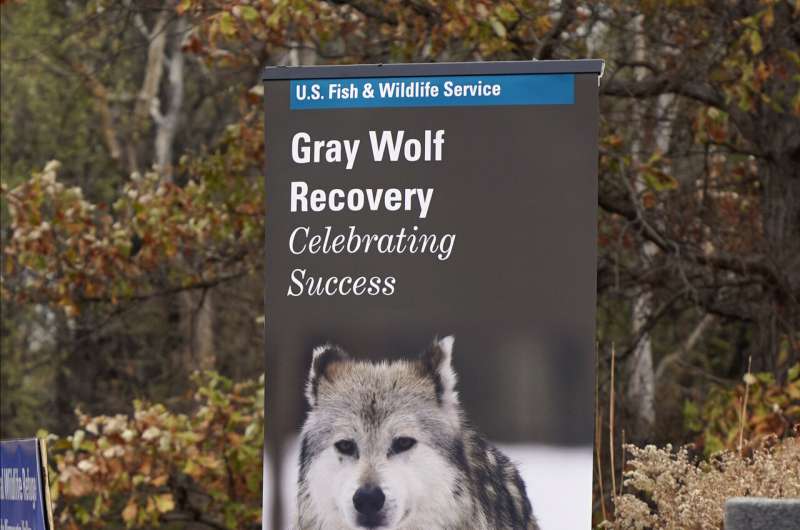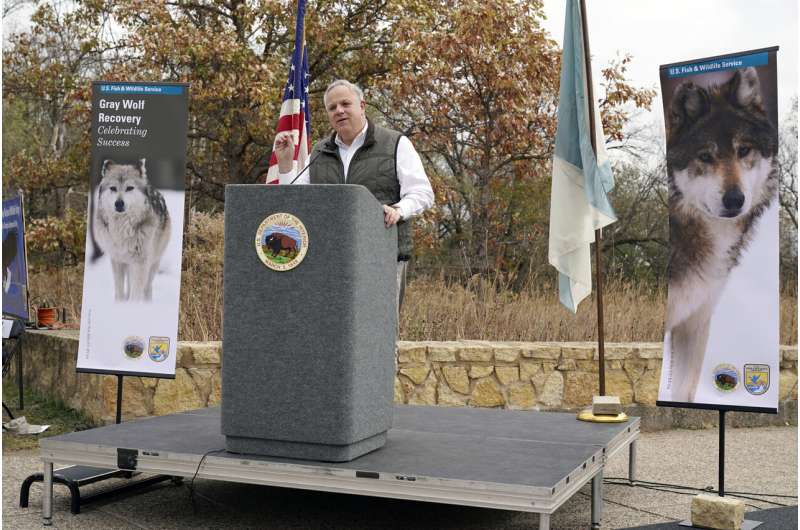This June 30, 2017 remote camera image released by the U.S. Forest Service shows a female gray wolf and her mate with a pup born in 2017 in the wilds of Lassen National Forest in Northern California. Trump administration officials on Thursday, Oct. 29, 2020, stripped Endangered Species Act protections for gray wolves in most of the U.S., ending longstanding federal safeguards and putting states in charge of overseeing the predators. (U.S. Forest Service via AP, File)
Wildlife advocates and environmental groups have announced that they are challenging the removal of federal protections for gray wolves across most of the U.S.
Two coalitions of groups filed formal notices over the past several days that they plan to sue the U.S. Interior Department in federal court unless protections are restored. The notices are required as a precursor to lawsuits brought under the Endangered Species Act.
The Trump administration last week finalized a decision that ends longstanding federal safeguards for gray wolves in the Lower 48 states except for a small population of Mexican gray wolves in the Southwest.
The move puts states and tribes in charge of overseeing the predators and could allow hunting to resume in Michigan, Minnesota and Wisconsin.
Gray wolves have recovered from near extinction in parts of the country with thousands now roaming the northern Rocky Mountains and western Great Lakes region and growing numbers of the animals in the Pacific Northwest.
But they remain absent from much of their historical range and wildlife advocates have said protections still are needed.
Colorado wildlife officials say they are planning to reintroduce wolves in the state in coming years under a voter-approved ballot initiative.
-
This June 29, 2017, file remote camera image provided by the U.S. Forest Service shows a female gray wolf and two of the three pups born in 2017 in the wilds of Lassen National Forest in Northern California. Trump administration officials on Thursday, Oct. 29, 2020, stripped Endangered Species Act protections for gray wolves in most of the U.S., ending longstanding federal safeguards and putting states in charge of overseeing the predators. (U.S. Forest Service via AP, File)
-
In this Dec. 4, 2014, file photo, released by the Oregon Department of Fish and Wildlife, a wolf from the Snake River Pack passes by a remote camera in eastern Wallowa County, Ore. Trump administration officials on Thursday, Oct. 29, 2020, stripped Endangered Species Act protections for gray wolves in most of the U.S., ending longstanding federal safeguards and putting states in charge of overseeing the predators. (Oregon Department of Fish and Wildlife via AP, File)
-
Interior Secretary David Bernhardt announces the gray wolf's recovery "a milestone of success" during a stop at the Minnesota Valley National Wildlife Refuge, Thursday, Oct. 29, 2020, in Bloomington, Minn. The move stripped Endangered Species Act protections for gray wolves in most of the U.S., ending longstanding federal safeguards and putting states and tribes in charge of overseeing the predators. (AP Photo/Jim Mone)
-
A photos of a gray wolf is displayed near the podium where Interior Secretary David Bernhardt announced the gray wolf's recovery "a milestone of success during a stop at the Minnesota Valley National Wildlife Refuge, Thursday, Oct. 29, 2020, in Bloomington, Minn. The move stripped Endangered Species Act protections for gray wolves in most of the U.S., ending longstanding federal safeguards and putting states and tribes in charge of overseeing the predators. (AP Photo/Jim Mone)
-
Flanked by photos of gray wolves, Interior Secretary David Bernhardt announces the gray wolf's recovery "a milestone of success" during a stop at the Minnesota Valley National Wildlife Refuge, Thursday, Oct. 29, 2020, in Bloomington, Minn. The move stripped Endangered Species Act protections for gray wolves in most of the U.S., ending longstanding federal safeguards and putting states and tribes in charge of overseeing the predators. (AP Photo/Jim Mone)
© 2020 The Associated Press. All rights reserved. This material may not be published, broadcast, rewritten or redistributed without permission.
